| Revision as of 12:05, 5 October 2005 editPiCo (talk | contribs)Extended confirmed users, Pending changes reviewers44,429 edits →List of Australian artists← Previous edit | Latest revision as of 04:42, 20 October 2024 edit undoThe ed17 (talk | contribs)Autopatrolled, Administrators73,726 editsm Reverted edit by GorillaWarfareMaster (talk) to last version by AlexeyevitchTag: Rollback | ||
| Line 1: | Line 1: | ||
| {{short description|Art made by Australians or in Australia}} | |||
| ] is home to perhaps the oldest continuous ]istic traditions in the world - that is, those of the ]s, an artistic tradition that began to receive international recognition in the late ]. It has also produced notable artists coming out of Western traditions whose most distinctively Australian feature is the gradual development of a way to represent the equally distinctive Australian landscape. | |||
| {{Use dmy dates|date=June 2023}} | |||
| {{Use Australian English|date=June 2013}} | |||
| {{Culture of Australia}} | |||
| '''Australian art''' is a broad spectrum of ] created in or about ], or by Australians overseas, spanning from ] times to the present day. The art forms include, but are not limited to, ], Colonial, ], ], and ]. | |||
| ==Aboriginal art== | |||
| The visual arts in Australia have a rich and extensive history, with Aboriginal art dating back at least 30,000 years. The country has been the birthplace of many notable artists from both ] and ] schools. These include the late-19th-century ] plein air painters, the ], the Central Australian ] watercolorists, and the ]. The Australian art scene also features significant examples of ] and ]. | |||
| :''See main article ]'' | |||
| ==History== | |||
| Australia has a long tradition of Aboriginal art which is thousands of years old. Modern Aboriginal artists continue the tradition using modern materials in their artworks. Aboriginal art is the most internationally recognisable form of Australian art. | |||
| ===Indigenous Australia=== | |||
| ] in the ] region of Western Australia]] | |||
| The ancestors of ] are believed to have arrived in Australia as early as 60,000 years ago, and evidence of ] in Australia can be traced back at least 30,000 years.<ref>{{cite web | |||
| |url=http://www.cultureandrecreation.gov.au/articles/indigenous/art/index.htm | |||
| |title=Indigenous art | |||
| |work=Australian Culture and Recreation Portal | |||
| |publisher=Australia Government | |||
| |access-date=26 September 2010 | |||
| |url-status=dead | |||
| |archive-url=https://web.archive.org/web/20100416144209/http://www.cultureandrecreation.gov.au/articles/indigenous/art/index.htm | |||
| |archive-date=16 April 2010 | |||
| }}</ref> Examples of ancient Aboriginal rock artworks can be found throughout the continent. Notable examples can be found in national parks, such as those of the ] listed sites at ] and ] in the Northern Territory, and the ] in the ]. Rock art can also be found within protected parks in urban areas such as ] in Sydney.<ref>{{Cite web|title=Kakadu National Park|url=https://parksaustralia.gov.au/kakadu/index.html|access-date=2020-08-27|website=parksaustralia.gov.au}}</ref><ref> {{webarchive|url=https://web.archive.org/web/20091227150948/http://www.environment.gov.au/parks/uluru/index.html |date=27 December 2009 }}</ref><ref> {{webarchive|url=https://web.archive.org/web/20130129174555/http://www.auinfo.com/Ku_Ring_Gai_National_park_Sydney.html |date=29 January 2013 }}</ref> The ] are approximately 5000 to 200 years old. ] in Western Australia has the Friends of Australian Rock Art advocating its preservation, and the numerous engravings there were heritage listed in 2007.<ref>* ABC Online 10.02.09 </ref><ref>Phillips, Yasmine: World protection urged for Burrup art. 13.01.09 {{dead link|date=June 2016|bot=medic}}{{cbignore|bot=medic}}</ref> | |||
| In terms of age and abundance, cave art in Australia is comparable to that of ] and ] in Europe,<ref>, Australian Museum</ref> and Aboriginal art is believed to be the oldest continuing tradition of art in the world.<ref name="NGVindig">{{cite web |url=http://www.ngv.vic.gov.au/whats-on/exhibitions/exhibitions/the-indigenous-collection |title=The Indigenous Collection |work=The Ian Potter Centre: NGV Australia |publisher=National Gallery of Victoria |access-date=6 December 2010 |archive-url=https://web.archive.org/web/20101007081213/http://www.ngv.vic.gov.au/whats-on/exhibitions/exhibitions/the-indigenous-collection |archive-date=7 October 2010 |url-status=dead }}</ref> There are three major regional styles: the geometric style found in Central Australia, Tasmania, the Kimberley and Victoria known for its concentric circles, arcs and dots; the simple figurative style found in ]; the complex figurative style found in Arnhem Land which includes X-Ray art.<ref> Arnhem Land Rock Art on Archaeology TV</ref> These designs generally carry significance linked to the spirituality of the ].<ref>, australia.gov.au {{webarchive |url=https://web.archive.org/web/20100416144209/http://www.cultureandrecreation.gov.au/articles/indigenous/art/index.htm |date=16 April 2010 }}</ref> | |||
| {{sectstub}} | |||
| ] | |||
| ==Early Colonial Art== | |||
| ] ({{circa}} 1824–1903) was one of the last traditionally educated of the ]-Willam people who come from the district now incorporating the city of Melbourne. He remains notable for his artworks which recorded traditional Aboriginal ways for the education of Westerners (which remain on permanent exhibition at the ] of the ] and the ]). ] (1875–1963) was among the early non-indigenous painters to incorporate Aboriginal influences in her works. ] (1902–1959) is a famous Australian artist and an ] man. His landscapes inspired the ] of art.<ref>{{Cite web | url=http://www.hermannsburgschool.com/ |title = Hermannsburg School}}</ref> ] works, which notably fuse Western and indigenous influences, are significant. Since the 1970s, indigenous artists have employed the use of acrylic paints – with styles such as the ] becoming globally renowned 20th-century art movements. | |||
| The ] exhibits a great many indigenous art works, including those of the ] who are known for their traditional sculpture and headgear.<ref>{{Cite web|title=Aboriginal & Torres Strait Islander art|url=https://nga.gov.au/atsiart/index.cfm|access-date=2020-08-27|website=nga.gov.au}}</ref> The ] has an extensive collection of indigenous Australian art. In May 2011, the Director of the Place, Evolution, and Rock Art Heritage Unit (PERAHU) at ], ], called for the creation of a national database for rock art.<ref>{{cite web|url=http://www.griffith.edu.au/humanities-languages/school-humanities/research/protect-australias-spirit |title=Protect Australia's Spirit – Griffith University |access-date=2011-12-16 |url-status=dead |archive-url=https://web.archive.org/web/20120117223527/http://www.griffith.edu.au/humanities-languages/school-humanities/research/protect-australias-spirit |archive-date=17 January 2012}}{{dead link|date=February 2022}}</ref> Paul Taçon launched the "Protect Australia's Spirit" campaign in May 2011 with the Australian actor ].<ref>{{YouTube|XJCcAElSYaU|Protect Australia's Spirit: Interview with Prof. Paul Tacon and Jack Thompson}}</ref> This campaign aims to create the very first fully resourced national archive to bring together information about rock art sites, as well as planning for future rock art management and conservation. The National Rock Art Institute would bring together existing rock art expertise from ], ], and the ] if they were funded by philanthropists, big business and government. ] is published twice a year and also covers international scholarship of rock art. | |||
| The first depictions of Australia by European artists were mainly "natural-history art", depicting the distinctive flora and fauna for scientific purposes. Sydney Parkinson, the plant draftsperson on ]'s 1770 voyage that first charted the eastern coastline of Australia, made a large number of such drawings under the direction of naturalist ]. | |||
| ===Early European depictions=== | |||
| Despite Banks' suggestions, no professional natural-history artist sailed on the ] in 1788, so until the turn of the century all drawings made in the colony were by soldiers, including naval officers George Raper and John Hunter, and convict artists, including Thomas Watling. However, many of these drawings are by unknown artists. Most are in the style of naval draughtsmanship. Most of these drawings were of natural-history topics, specifically birds, but a few depict the infant colony itself. Several professional natural-history illustrators accompanied expeditions in the early 19th century, including ] (who travelled with ]), and ], who travelled with a French expedition led by ]. The first resident professional artist was John Lewin, who arrived in 1800 and published two volumes of natural-history art. | |||
| ], '']'', 1772]] | |||
| The first artistic representations of the Australia scene by European artists were mainly ] illustrations, depicting the distinctive flora and fauna of the land for scientific purposes, and the topography of the coast. ], the ] on ]'s 1770 voyage that first charted the eastern coastline of Australia, made a large number of such drawings under the direction of naturalist ]. Many of these drawings were met with scepticism when taken back to Europe, for example claims that the ] was a hoax. In the form of copies and reproductions, ]' 1772 paintings '']'' and '']''—depicting a dingo and kangaroo respectively—were the first images of Australian fauna to be widely disseminated in Britain. | |||
| ===British colonization (1788–1850)=== | |||
| Early Western art in Australia, from British colonisation in 1788 onwards, is often narrated as the gradual shift from a European sense of light to an Australian one. The lighting in Australia is notably different from that of Europe, and early attempts at landscapes attempted to reflect this. It has also been one of transformation, where artistic ideas originating from beyond (primarily Europe) gained new meaning and purpose when transplanted into the new continent and the emerging society.<ref name="Christopher Allen 1997">''Art in Australia: From Colonization to Postmodernism.'' ] (1997). Thames and Hudson, World of Art series.</ref> | |||
| Despite Banks' suggestions, no professional natural-history artist sailed on the ] in 1788. Until the turn of the century all drawings made in the colony were crafted by soldiers, including British naval officers ] and ], and convict artists, including ].<ref name="James Gleeson 1971">James Gleeson, Australian Painting. Edited by John Henshaw. 1971.</ref> However, many of these drawings are by unknown artists, most notably the ]. Most are in the style of naval draughtsmanship, and cover natural history topics, specifically birds, and a few depict the infant colony itself. | |||
| == Early 19th Century == | |||
| ] | |||
| As well as natural history, there were some ethnographic portraiture of Aborigines, particularly in the 1830s. Some of the most notable artists include Augustus Earle, in New South Wales, and Thomas Bock. | |||
| Several professional natural-history illustrators accompanied expeditions in the early 19th century, including ], who travelled with ], and ], who travelled with a French expedition led by ]. The first resident professional artist was ],<ref name="James Gleeson 1971" /> who arrived in 1800 and published two volumes of natural history art. Ornithologist ] was renowned for his illustrations of the country's birds.<ref name="James Gleeson 1971" /> In the late 19th century ] and ] were highly respected natural history illustrators<ref>{{Cite web | url=http://australianmuseum.net.au/Beauty-from-Nature-art-of-the-Scott-Sisters |title = The Scott sisters collection}}</ref> | |||
| Lewin's ''Platypus'' (1808) represents the fine detail and scientific observation displayed by many of these early painters. | |||
| As well as inspiration in natural history, there were some ethnographic portraiture of ], particularly in the 1830s. Artists included ] in ]<ref name="James Gleeson 1971" /> and ], ] and the sculptor Benjamin Law, recording images of ]. | |||
| Conrad Martens worked from 1835 to 1878 as a professional artists, painting many landscapes. He was commercially successful. His work, though, is regarded as softening the landscape to fit European sensibilities. Another significant landscape artist of this era was ]. | |||
| The most significant landscape artist of this era<ref name="Christopher Allen 1997" /> was ]. Heavily influenced by 18th-century European landscape painters, such as ] and ], his works captured the distinctive Australian features of open country, fallen logs, and blue hills.<ref name="Bernard Smith 2001">''Australian Painting: 1788–2000.'' Bernard Smith with Terry Smith and Christopher Heathcote (2001). Oxford University Press.</ref> | |||
| A few attempts at art exhibitions were made in the 1840s, which attracted a number of artists but were unfortunately commercial failures. By the 1850s however, regular exhibitions became popular, with a huge variety of art types represented. The first such was in 1854 in Melbourne. An art museum, which eventually became the ], was founded in 1861, and began to collect Australian works as well as gathering a collection of European masters. Some of the artists of note included Eugene von Guerard, Thomas Strutt, and ]. | |||
| ] (1801–1878) worked from 1835 to 1878 as a professional artist, painting many landscapes and was commercially successful. His work has been regarded as softening the landscape to fit European sensibilities.<ref name="James Gleeson 1971" /> His watercolour studies of Sydney Harbour are well regarded, and seen as introducing ] ideals to his paintings.<ref name="Bernard Smith 2001" /> Martens is also remembered for accompanying scientist ] on ] (as had ]). | |||
| == Heidelberg School == | |||
| <gallery widths="200px" heights="200px"> | |||
| The beginnings of Australian art are often popularly associated with the ] in the 1880s. Some historians, including Sayers (2001), regard this as an exaggeration, noting earlier nineteeth century artists, as well as contemporary artists (particularly women) not recognised as part of this movement, as well as noting the strong connections between the art of the school and the wider ] movement. However, even given these qualifications, Sayers states that "there remains something excitingly original and indusitably important in the art of the 1880s and 1890s", and that by this time "something which could be described as an Australian tradition began to be recognized". | |||
| Thomas Watling - A Direct North General View of Sydney Cove, 1794.jpg|Thomas Watling, ''A Direct North General View of Sydney Cove'', 1794 | |||
| William Westall - View of Sir Edward Pellews Group, Gulph of Carpentaria, 1802.jpg|], ''View of Sir Edward Pellews Group, Gulph of Carpentaria'', 1802 | |||
| Augustus Earle A bivouac of travellers in Australia.jpg|Augustus Earle, ''A bivouac of travellers in Australia in a cabbage-tree forest, day break'', 1838 | |||
| Image:Conrad Martens - Campbells Wharf, 1857.jpg|Conrad Martens, ''Campbell's Wharf'', {{circa}} 1857 | |||
| </gallery> | |||
| ===Gold rushes and expansion (1851–1885)=== | |||
| ]]] | |||
| ] | |||
| Some the key figures in the School were ], ], ], and ]. Their most recognised work involves scenes of pastoral and wild Australia, featuring the vibrant, even harsh colours of Australian summers. The name itself comes from a camp Roberts and Streeton set up at a property near Heidelberg, at the time on the rural outskirts of ]. Some of their paintings received international recognition, and many remain embedded in Australia's popular consciousness both inside and outside the art world. | |||
| From 1851, the ] resulted in a huge influx of settlers and new wealth. ] (1818–1880) documented life on the Australian gold fields,<ref name="James Gleeson 1971" /> however the colonial art market primarily desired landscape paintings, which were commissioned by wealthy landowners or merchants wanting to record their material success.<ref>{{Cite web|title=National Gallery of Australia. Travelling exhibitions|url=http://nga.gov.au/Exhibition/OceantoOutback/pdf/O2OEDUKIT.pdf|access-date=2020-08-27|website=National Gallery of Australia}}</ref> | |||
| ]'s (1836–1914) "Flood in the Darling" was acquired by the National Gallery of New South Wales in 1895.<ref name="ReferenceA">McCulloch, Alan McCulloch, Susan McCulloch & Emily McCulloch Childs: ''McCulloch's Encyclopedia of Australian Art'' Melbourne University Press, 2006</ref> | |||
| Some of the artists of note included ], ], ], ] and ]. | |||
| == 20th Century == | |||
| ] | |||
| Leading up to ], the decorative arts, including miniature, watercolour painting, and functional objects such as vases, became more prominent in the Australian arts scene. ]'s works caused considerable scandal around the turn of the century. One famous drawing, ''Politice verso'', caused his first scandal, as it depicted a "writhing bacchanal of nude Romans" giving the thumbs-down to "a scrawny figure hung on a cross". By this time, women's artworks started to attract wider attention, such as the pastels of Florence Rodway, or the paintings of ], who painted the ] as it was being constructed. | |||
| ] was a key figure in landscape painting in the later period. He was influenced by the ] painters, and so using a '']'' technique, and a more domesticated and settled view of the land, in contrast to the emphasis on strangeness or danger prevalent in earlier painters. This approach, together with his extensive teaching influence, have led his to dubbed the "Father of Landscape Painting in Australia".<ref name="Bernard Smith 2001" /> | |||
| A few attempts at art exhibitions were made in the 1840s, which attracted a number of artists but were commercial failures. By the 1850s, however, regular exhibitions became popular, with a variety of art types represented. The first of these exhibitions was in 1854 in Melbourne. An art museum, which eventually became the ], was founded in 1861, and it began to collect Australian works as well as gathering a collection of European masters. Crucially, it also opened an art school, important for the following generations of Australian-born and raised artists. | |||
| ]]] | |||
| After ], ] art began to make its presence felt in the Australian art community, causing considerable controversy between its practitioners and detractors (though this is probably an oversimplification). 1921 saw the founding of the ], Australia's most famous art prize, for ], though defining portraiture has always caused controversy - most notably in 1943 when ]'s highly figurative portrait of an artist friend won the prize and was challenged in court on the basis that it was a caricature, not a portrait. Also notable in the 1930s period was the photography of ], whose images of bronzed (often nude) Australians on dazzlingly-lit beaches added to the mythological connection of white Australia to its coastline. | |||
| ], a professional photographer and student of Buvelot, painted the large-scale bush scene ''Evening Shadows'' (1880), the first acquisition of the ] and possibly Australia's most reproduced painting.<ref>, Art Gallery of South Australia. Retrieved 27 February 2017.</ref> | |||
| In the 1930s and 1940s the opening up of Australia's interior saw an increasing cross-pollination between Western and Aboriginal art, with European artists imitating Aboriginal styles and some Aboriginal artists adopting Western techniques. The most famous of these is undoubtedly ]. | |||
| <gallery widths="195px" heights="195px"> | |||
| In the 1940s a new generation of artists began experimenting with styles such as ] and other techniques. ] and ] were prominent, and a number of artists spent time at ], a house in Heidelberg - the site of the Heidelberg school several decades before. Amongst the artists that spent time there are ] and, most prominently ], the best known artist of the immediate postwar period. The effect of the ] poetry case, its cover illustrated by Nolan, also reflected around the art world. | |||
| Robert Dowling - Group of natives of Tasmania - Google Art Project.jpg|Robert Dowling, ''Group of Natives of Tasmania'', 1860 | |||
| Nicholas Chevalier - Mount Arapiles and the Mitre Rock - Google Art Project.jpg|Nicholas Chevalier, ''Mount Arapiles and the Mitre Rock'', 1863 | |||
| William Strutt Black Thursday detail.jpg|William Strutt, '']'' (detail), 1864 | |||
| H J. Johnstone - Evening shadows, backwater of the Murray, South Australia - Google Art Project.jpg|H. J. Johnstone, ''Evening Shadows'', 1880 | |||
| </gallery> | |||
| ===Australian impressionists (1885–1900)=== | |||
| The aspects of Australia's landscape depicted by artists continued to widen, with the suburban landscape brought to attention by such artists as John Brack. One of the more well-known modern painters was the Sydney artist ], who returned to Australia in the 1970s after spending time in London and, amongst other subjects, produced many landscape of Sydney and its waterside environs. | |||
| ], '']'', 1886]] | |||
| The origins of a distinctly Australian painting tradition is often associated with the ] of the late 19th century. Named after a camp ] and ] established in ] (then a rural suburb on the outskirts of Melbourne), these painters, together with ], ]<ref name="autogenerated1"/> and others, began an impressionistic ''plein air'' approach to the Australian landscape that remains embedded in Australia's popular consciousness, both in and outside the art world. | |||
| ]'', 1890]] | |||
| In 1971-2 art teacher Geoffrey Bardon encouraged the Aboriginal people of Papunya to paint their Dreamtime stories on canvas, leading to the development of the Papunya Tula school, or 'dot art' which has become possibly Australia's most recognisable style of art worldwide. ] was one of the most well known of these artists that came from Papunya. | |||
| Many of their most famous works depict scenes of pastoral and outback Australia. Central themes of their art include manual labour, conquering the land,<ref name = "Christopher Allen 1997"/> and an idealisation of the rural pioneer.<ref name = "Bernard Smith 2001"/> By the 1890s most Australians were city-dwellers, as were the artists themselves, and a romantic view of pioneer life gave great power and popularity to images such as '']''.<ref name="Bernard Smith 2001"/> In this work Roberts uses formal composition and strong realism to dignify the shearers<ref name = "Bernard Smith 2001"/> whilst the relative anonymity of the men and their subdued expressions, elevate their work as the real subject, rather that the specific individuals portrayed.<ref name = "Christopher Allen 1997"/> | |||
| In their portrayal of the nobility of rural life, the Heidelberg artists reveal their debt to ], ] and ], but the techniques and aims of the French ]s provide more direct inspiration and influenced their actual practise. In their early and extremely influential ] of small sketches, their impressionistic programme was clear, as evidenced from their catalogue: "An effect is only momentary: so an impressionist tries to find his place... it has been the object of artists to render faithfully, and thus obtain first records of effects widely differing, and often of very fleeting character."<ref name="Bernard Smith 2001"/> | |||
| The 1970s saw the widespread introduction of the government funding of Australian arts, and thousands of artists continue to produce a huge variety of works in media from oils to digital projection. The ] was opened in 1982, and the state galleries have continued to expand. | |||
| Other significant painters associated with the Heidelberg painters were ], who won the inaugural ] in 1896,<ref name="autogenerated1">Alan McCulloch, Golden Age of Australian Painting: Impressionism and the Heidelberg School</ref> and ], a student of McCubbin. Born and raised in Sydney, impressionist ] spent much of his career in Europe, where he befriended the likes of ] and ]. He also wrote letters home to his friend, Tom Roberts, updating him on developments in French impressionism. | |||
| Modern Australian artists such as ] and ] have increasingly used photography and video in their works. Some modern Aboriginal artists use a ] style of painting such as ]. | |||
| <gallery widths="195px" heights="195px"> | |||
| == List of Australian artists == | |||
| Charles Conder - A holiday at Mentone - Google Art Project.jpg|Charles Conder, '']'', 1888 | |||
| McCubbin(1).jpg|Frederick McCubbin, '']'', 1893 | |||
| Emanuel Phillips Fox - Art Students, 1895.jpg|E. Phillips Fox, ''Art Students'', 1895 | |||
| Arthur Streeton Purple 1896.jpg|Arthur Streeton, '']'', 1896 | |||
| </gallery> | |||
| ===Federation era and World War I (1901–1918)=== | |||
| Colonial period | |||
| In 1901, the six self-governing Australian colonies ] to form a unified nation. Artists such as ] and ] built on the Australian landscape tradition of the Heidelberg painters, creating grand, nationalist pastoral landscapes. Others moved on to successful careers in London and Paris, such as ] and ]. | |||
| <gallery widths="195px" heights="195px"> | |||
| George W Lambert - Miss Thea Proctor - Google Art Project.jpg|], '']'', 1903 | |||
| Hugh Ramsay - The sisters - Google Art Project.jpg|Hugh Ramsay, ''The Sisters'', 1904 | |||
| Elioth Gruner - Spring frost - Google Art Project.jpg|Elioth Gruner, '']'', 1918 | |||
| Heysen Droving.jpg|Hans Heysen, '']'', 1921 | |||
| </gallery> | |||
| === 1920s onwards === | |||
| 19th Century | |||
| Among the public, through the 1920s, modified forms of Impressionism were popular, with ] being considered the last of the Australian Impressionists.<ref name="atoa">{{cite book |last1=Splatt |first1=William |last2=Burton |first2=Barbara |date=1977 |title=A Treasury of Australian Landscape Painting |url=https://catalogue.nla.gov.au/Record/1417435/Details |publisher=Rigby |page=36 |isbn=9780859020138}}</ref> The ] movement, originating in the writings and teaching of ], followed a 'scientific' transcription of tonal relations, making 'impressionism' a system, and opposed ] art then emerging pre-WW2 in the ] and the ] influenced by refugees from Europe, and Australian-born artists' visits to England and France. Conservatives' attitudes to 'modern art' prevailed until the 1960s, institutionalised in the ] (1937–1947), opposed by such groups as the ] (established 1938 and continuing).<ref name="ReferenceA" /> | |||
| The 1950s restored an interest in the ] as subject matter in Australian art.<ref name="atoa"/> ] and ] toured the interior, sponsored by newspapers to document drought. They and ], in his ''Explorer'' series, sought to capture the ancient strangeness and a cruel infinity of the central Australian landscape.<ref name="atoa"/> | |||
| 20th Century | |||
| ] | |||
| ] | |||
| ] | |||
| ] | |||
| ] | |||
| ] | |||
| ] | |||
| ] | |||
| Splatt and Burton (1977) consider the 1960s a period in which public attention was being drawn to urban bushland and that landscape paintings of the 1970s carried through on the themes of environmental preservation and threats of destruction.<ref name="atoa"/> | |||
| Contemporary (living) artists | |||
| ] | |||
| ] | |||
| ] | |||
| ] | |||
| ] | |||
| ] | |||
| ] | |||
| ] | |||
| ] | |||
| ] | |||
| ] | |||
| ] | |||
| ] | |||
| == List of artists == | |||
| Schools | |||
| {{Main|List of Australian artists|:Category:Australian sculptors|:Category:Australian photographers}} | |||
| == Art museums and galleries in Australia == | |||
| ==See also== | |||
| ]]] | |||
| *] | |||
| {{Main|List of art museums and galleries in Australia |:Category:Art museums and galleries in Australia}} | |||
| *] | |||
| ] at the Albert Namatjira Gallery, ] Cultural Precinct, in 2007]] | |||
| *] | |||
| *] | |||
| == Institutions == | |||
| ] | |||
| Australia has major art museums and galleries subsidised by the national and state governments, as well as private art museums and small university and municipal galleries. The ], the ] and the ] have major strengths in collecting the art of the Asia Pacific Region. Others include the ] in Melbourne, which has a significant Australian collection of Western art. ], Sydney, and the privately owned ] in Hobart, Tasmania and ] in Sydney are widely regarded as autonomously discerning collections of international contemporary art. | |||
| Other institutions include the ] in Adelaide, Newcastle Art Gallery, the ], the ], the ], the ] in Hobart, the ] in Darwin, and the ] in Perth. A network of regional public galleries have existed since the mid-1800s and one, ], is unique in specialising in Australian art. The ] holds a significant collection comprising more than a quarter of a million artworks,<ref>, ]</ref> many from the colonial period. More material is held by other national and state libraries. | |||
| == Art market == | |||
| The boom and bust cycle in contemporary art is evident in the 1980s colonial art boom ending at the time of the ] and the exit of many artists and dealers, followed by the 2000s boom in Aboriginal dot painting and Australian late modernist painting, which ended at the time of the global financial crisis and growing collector and public interest in the international contemporary art circuit. | |||
| A 5% resale royalty scheme commenced in 2010 under which artists receive 5% of the sale price when eligible artworks are resold commercially for $1000 or more. Between 10 June 2010 and 15 May 2013, the scheme generated over $1.5 million in royalties for 610 artists.<ref>{{Cite web|last=Arts|first=Department of Communications and the|date=2019-12-17|title=Resale Royalty Scheme|url=https://www.arts.gov.au/funding-and-support/resale-royalty-scheme|access-date=2020-08-27|website=arts.gov.au|language=en}}</ref> Some buyers object to paying any resale royalty while others do not mind a royalty going directly to the artists. However, they worry about further red tape and bureaucratic interference. | |||
| In 2014/15 there was a rediscovery of colonial art at auction. Affordable 20th-century rural scene painting is buoyant. While the inflated northern hemisphere art markets had anticipating a massive correction in the Australian art market which transitioned to the middle market. | |||
| Socially oriented art events such as art fairs and biennials have continued to grow in size and popularity in the contemporary art scene.<ref>{{Cite web|title=Artforum.com|url=https://www.artforum.com/artguide/artfairs|access-date=2020-08-27|website=artforum.com|language=en-US}}</ref><ref>{{Cite web|date=2019-08-22|title=Top 38 International Art Fairs To Attend|url=https://www.plepaulmier.com/blog/top-38-international-art-fairs/|access-date=2020-08-27|website=Le Paulmier Photography|language=en-US}}</ref> | |||
| The smaller commercial galleries have struggled to remain in business in the 2010s in spite of a functioning economy, although there is little consensus on the reasons for this.<ref>{{Cite web|last=Preiss|first=Andrea Petrie and Benjamin|date=2013-05-11|title=Bleak picture emerges as galleries battle to hang in|url=https://www.smh.com.au/entertainment/art-and-design/bleak-picture-emerges-as-galleries-battle-to-hang-in-20130511-2jf0b.html|access-date=2020-08-27|website=The Sydney Morning Herald|language=en}}</ref><ref>{{Cite web|last=Fairley|first=Gina|title=Why are so many commercial galleries closing?|url=https://visual.artshub.com.au/news-article/news/visual-arts/gina-fairley/why-are-so-many-commercial-galleries-closing-254259|access-date=2020-08-27|website=ArtsHub Australia|date=16 August 2017 |language=en-au}}</ref> | |||
| A new market has arisen in China, where Australian artists are selling works in a traditionally local market: "While the Chinese have always had a passion for traditional Chinese art, according to global auction house Sotheby's, the surging interest in contemporary international art is a recent trend."<ref>{{Cite web|date=2018-09-28|title=Aussie artists eye cashed-up Chinese buyers spending big on contemporary art|url=https://www.abc.net.au/news/2018-09-29/australian-artists-eye-cashed-up-chinese-buyers/10307270|access-date=2020-08-27|publisher=ABC News|location=Australia|language=en-AU}}</ref> | |||
| The market for Aboriginal art is still very strong, on the national and international stage, since becoming a solid financial investment in the 1980s.<ref>{{Cite web|title=History and Emergence of Aboriginal Art|url=https://japingkaaboriginalart.com/emergence-of-aboriginal-art/|access-date=2020-08-27|website=Japingka Aboriginal Art Gallery}}</ref> Not only do all the regional and State Galleries acquire significant collections of Aboriginal art, but private galleries are showing featured artists abroad.<ref>{{Cite web|title=Desert Blossoms of Bush Medicine 'Akwerlp Alpeyt Artna Arntetyew' – Art Exhibition|url=https://michaelreid.com.au/exhibition/artists-of-ampilatwatja/|access-date=2020-08-27|website=Michael Reid Gallery}}</ref> Aboriginal artists are also represented in all the major landscape prizes Australia.<ref>{{Cite web|title=Indigenous artist wins landscape art prize|url=https://www.sbs.com.au/news/indigenous-artist-wins-landscape-art-prize|access-date=2020-08-27|website=SBS News|language=en}}</ref> In 2019, "the Wynne prize, worth $50,000, was won by ] for her painting Seven Sisters – marking the fourth year in a row that the landscape prize has been won by Indigenous artists."<ref>{{Cite news|date=2019-05-10|title=Tony Costa named winner of 2019 Archibald prize for portrait of Lindy Lee|work=]|url=https://www.theguardian.com/artanddesign/2019/may/10/tony-costa-named-winner-of-2019-archibald-prize-for-portrait-of-lindy-lee|access-date=2020-08-27}}</ref> | |||
| ==Australian visual arts in other countries== | |||
| The museum for Australian Aboriginal art 'La grange' in ], Switzerland, was one of the few museums in Europe that dedicated itself entirely to Aboriginal art.<ref>{{Cite web|title=Fondation Burkhardt-Felder {{!}} Arts et Culture|url=https://ww2.fondation-bf.ch/|access-date=2020-08-27|language=fr-FR}}</ref><ref>{{Cite web|url=https://ww2.fondation-bf.ch/actual-exhibition/?lang=en|title=Current Exhibition {{!}} Fondation-bf|language=en-US|access-date=2020-02-13}}</ref> | |||
| == See also == | |||
| * ] | |||
| * ] | |||
| * ] | |||
| * ] | |||
| * ] | |||
| * ] | |||
| == References == | |||
| {{reflist}} | |||
| == External links == | |||
| * | |||
| * | |||
| * | |||
| * | |||
| * | |||
| * | |||
| * (archived) | |||
| * (archived) | |||
| {{Oceanic topic|| art}} | |||
| {{Australianartawards}} | |||
| {{Australia topics}} | |||
| {{DEFAULTSORT:Visual Arts of Australia}} | |||
| ] | |||
| ] | |||
Latest revision as of 04:42, 20 October 2024
Art made by Australians or in Australia
| This article is part of a series on the |
| Culture of Australia |
|---|
 |
| Society |
| Arts and literature |
| Other |
| Symbols |
|
Australia portal |
Australian art is a broad spectrum of art created in or about Australia, or by Australians overseas, spanning from prehistoric times to the present day. The art forms include, but are not limited to, Aboriginal, Colonial, Landscape, Atelier, and Contemporary art.
The visual arts in Australia have a rich and extensive history, with Aboriginal art dating back at least 30,000 years. The country has been the birthplace of many notable artists from both Western and Indigenous Australian schools. These include the late-19th-century Heidelberg School plein air painters, the Antipodeans, the Central Australian Hermannsburg School watercolorists, and the Western Desert Art Movement. The Australian art scene also features significant examples of High modernism and Postmodern art.
History
Indigenous Australia
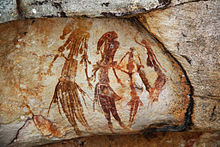
The ancestors of Aboriginal Australians are believed to have arrived in Australia as early as 60,000 years ago, and evidence of Indigenous Australian art in Australia can be traced back at least 30,000 years. Examples of ancient Aboriginal rock artworks can be found throughout the continent. Notable examples can be found in national parks, such as those of the UNESCO listed sites at Uluru and Kakadu National Park in the Northern Territory, and the Gwion Gwion rock paintings in the Kimberley region of Western Australia. Rock art can also be found within protected parks in urban areas such as Ku-ring-gai Chase National Park in Sydney. The Sydney rock engravings are approximately 5000 to 200 years old. Murujuga in Western Australia has the Friends of Australian Rock Art advocating its preservation, and the numerous engravings there were heritage listed in 2007.
In terms of age and abundance, cave art in Australia is comparable to that of Lascaux and Altamira in Europe, and Aboriginal art is believed to be the oldest continuing tradition of art in the world. There are three major regional styles: the geometric style found in Central Australia, Tasmania, the Kimberley and Victoria known for its concentric circles, arcs and dots; the simple figurative style found in Queensland; the complex figurative style found in Arnhem Land which includes X-Ray art. These designs generally carry significance linked to the spirituality of the Dreamtime.

William Barak (c. 1824–1903) was one of the last traditionally educated of the Wurundjeri-Willam people who come from the district now incorporating the city of Melbourne. He remains notable for his artworks which recorded traditional Aboriginal ways for the education of Westerners (which remain on permanent exhibition at the Ian Potter Centre of the National Gallery of Victoria and the Ballarat Fine Art Gallery). Margaret Preston (1875–1963) was among the early non-indigenous painters to incorporate Aboriginal influences in her works. Albert Namatjira (1902–1959) is a famous Australian artist and an Arrernte man. His landscapes inspired the Hermannsburg School of art. Elizabeth Durack's works, which notably fuse Western and indigenous influences, are significant. Since the 1970s, indigenous artists have employed the use of acrylic paints – with styles such as the Western Desert Art Movement becoming globally renowned 20th-century art movements.
The National Gallery of Australia exhibits a great many indigenous art works, including those of the Torres Strait Islands who are known for their traditional sculpture and headgear. The Art Gallery of New South Wales has an extensive collection of indigenous Australian art. In May 2011, the Director of the Place, Evolution, and Rock Art Heritage Unit (PERAHU) at Griffith University, Paul Taçon, called for the creation of a national database for rock art. Paul Taçon launched the "Protect Australia's Spirit" campaign in May 2011 with the Australian actor Jack Thompson. This campaign aims to create the very first fully resourced national archive to bring together information about rock art sites, as well as planning for future rock art management and conservation. The National Rock Art Institute would bring together existing rock art expertise from Griffith University, Australian National University, and the University of Western Australia if they were funded by philanthropists, big business and government. Rock Art Research is published twice a year and also covers international scholarship of rock art.
Early European depictions
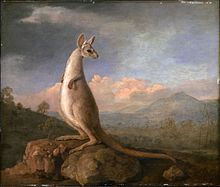
The first artistic representations of the Australia scene by European artists were mainly natural history illustrations, depicting the distinctive flora and fauna of the land for scientific purposes, and the topography of the coast. Sydney Parkinson, the botanical illustrator on James Cook's 1770 voyage that first charted the eastern coastline of Australia, made a large number of such drawings under the direction of naturalist Joseph Banks. Many of these drawings were met with scepticism when taken back to Europe, for example claims that the platypus was a hoax. In the form of copies and reproductions, George Stubbs' 1772 paintings Portrait of a Large Dog and The Kongouro from New Holland—depicting a dingo and kangaroo respectively—were the first images of Australian fauna to be widely disseminated in Britain.
British colonization (1788–1850)
Early Western art in Australia, from British colonisation in 1788 onwards, is often narrated as the gradual shift from a European sense of light to an Australian one. The lighting in Australia is notably different from that of Europe, and early attempts at landscapes attempted to reflect this. It has also been one of transformation, where artistic ideas originating from beyond (primarily Europe) gained new meaning and purpose when transplanted into the new continent and the emerging society.
Despite Banks' suggestions, no professional natural-history artist sailed on the First Fleet in 1788. Until the turn of the century all drawings made in the colony were crafted by soldiers, including British naval officers George Raper and John Hunter, and convict artists, including Thomas Watling. However, many of these drawings are by unknown artists, most notably the Port Jackson Painter. Most are in the style of naval draughtsmanship, and cover natural history topics, specifically birds, and a few depict the infant colony itself.

Several professional natural-history illustrators accompanied expeditions in the early 19th century, including Ferdinand Bauer, who travelled with Matthew Flinders, and Charles-Alexandre Lesueur, who travelled with a French expedition led by Nicolas Baudin. The first resident professional artist was John Lewin, who arrived in 1800 and published two volumes of natural history art. Ornithologist John Gould was renowned for his illustrations of the country's birds. In the late 19th century Harriet and Helena Scott were highly respected natural history illustrators Lewin's Platypus (1808) represents the fine detail and scientific observation displayed by many of these early painters.
As well as inspiration in natural history, there were some ethnographic portraiture of Aboriginal Australians, particularly in the 1830s. Artists included Augustus Earle in New South Wales and Benjamin Duterrau, Robert Dowling and the sculptor Benjamin Law, recording images of Aboriginal Tasmanians.
The most significant landscape artist of this era was John Glover. Heavily influenced by 18th-century European landscape painters, such as Claude Lorraine and Salvator Rosa, his works captured the distinctive Australian features of open country, fallen logs, and blue hills.
Conrad Martens (1801–1878) worked from 1835 to 1878 as a professional artist, painting many landscapes and was commercially successful. His work has been regarded as softening the landscape to fit European sensibilities. His watercolour studies of Sydney Harbour are well regarded, and seen as introducing Romantic ideals to his paintings. Martens is also remembered for accompanying scientist Charles Darwin on HMS Beagle (as had Augustus Earle).
-
 Thomas Watling, A Direct North General View of Sydney Cove, 1794
Thomas Watling, A Direct North General View of Sydney Cove, 1794
-
 William Westall, View of Sir Edward Pellews Group, Gulph of Carpentaria, 1802
William Westall, View of Sir Edward Pellews Group, Gulph of Carpentaria, 1802
-
 Augustus Earle, A bivouac of travellers in Australia in a cabbage-tree forest, day break, 1838
Augustus Earle, A bivouac of travellers in Australia in a cabbage-tree forest, day break, 1838
-
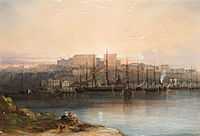 Conrad Martens, Campbell's Wharf, c. 1857
Conrad Martens, Campbell's Wharf, c. 1857
Gold rushes and expansion (1851–1885)

From 1851, the Victorian gold rush resulted in a huge influx of settlers and new wealth. S. T. Gill (1818–1880) documented life on the Australian gold fields, however the colonial art market primarily desired landscape paintings, which were commissioned by wealthy landowners or merchants wanting to record their material success.
William Piguenit's (1836–1914) "Flood in the Darling" was acquired by the National Gallery of New South Wales in 1895.
Some of the artists of note included Eugene von Guerard, Nicholas Chevalier, William Strutt, John Skinner Prout and Knud Bull.
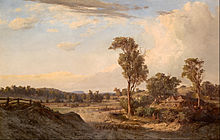
Louis Buvelot was a key figure in landscape painting in the later period. He was influenced by the Barbizon school painters, and so using a plein air technique, and a more domesticated and settled view of the land, in contrast to the emphasis on strangeness or danger prevalent in earlier painters. This approach, together with his extensive teaching influence, have led his to dubbed the "Father of Landscape Painting in Australia".
A few attempts at art exhibitions were made in the 1840s, which attracted a number of artists but were commercial failures. By the 1850s, however, regular exhibitions became popular, with a variety of art types represented. The first of these exhibitions was in 1854 in Melbourne. An art museum, which eventually became the National Gallery of Victoria, was founded in 1861, and it began to collect Australian works as well as gathering a collection of European masters. Crucially, it also opened an art school, important for the following generations of Australian-born and raised artists.
Henry James Johnstone (also known as H. J. Johnstone), a professional photographer and student of Buvelot, painted the large-scale bush scene Evening Shadows (1880), the first acquisition of the Art Gallery of South Australia and possibly Australia's most reproduced painting.
-
 Robert Dowling, Group of Natives of Tasmania, 1860
Robert Dowling, Group of Natives of Tasmania, 1860
-
 Nicholas Chevalier, Mount Arapiles and the Mitre Rock, 1863
Nicholas Chevalier, Mount Arapiles and the Mitre Rock, 1863
-
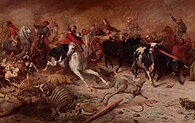 William Strutt, Black Thursday, February 6th (detail), 1864
William Strutt, Black Thursday, February 6th (detail), 1864
-
 H. J. Johnstone, Evening Shadows, 1880
H. J. Johnstone, Evening Shadows, 1880
Australian impressionists (1885–1900)

The origins of a distinctly Australian painting tradition is often associated with the Heidelberg School of the late 19th century. Named after a camp Tom Roberts and Arthur Streeton established in Heidelberg (then a rural suburb on the outskirts of Melbourne), these painters, together with Frederick McCubbin, Charles Conder and others, began an impressionistic plein air approach to the Australian landscape that remains embedded in Australia's popular consciousness, both in and outside the art world.

Many of their most famous works depict scenes of pastoral and outback Australia. Central themes of their art include manual labour, conquering the land, and an idealisation of the rural pioneer. By the 1890s most Australians were city-dwellers, as were the artists themselves, and a romantic view of pioneer life gave great power and popularity to images such as Shearing the Rams. In this work Roberts uses formal composition and strong realism to dignify the shearers whilst the relative anonymity of the men and their subdued expressions, elevate their work as the real subject, rather that the specific individuals portrayed.
In their portrayal of the nobility of rural life, the Heidelberg artists reveal their debt to Millet, Bastien-Lepage and Courbet, but the techniques and aims of the French Impressionists provide more direct inspiration and influenced their actual practise. In their early and extremely influential Exhibition of 9 by 5 Impressions of small sketches, their impressionistic programme was clear, as evidenced from their catalogue: "An effect is only momentary: so an impressionist tries to find his place... it has been the object of artists to render faithfully, and thus obtain first records of effects widely differing, and often of very fleeting character."
Other significant painters associated with the Heidelberg painters were Walter Withers, who won the inaugural Wynne Prize in 1896, and Jane Sutherland, a student of McCubbin. Born and raised in Sydney, impressionist John Russell spent much of his career in Europe, where he befriended the likes of Vincent van Gogh and Claude Monet. He also wrote letters home to his friend, Tom Roberts, updating him on developments in French impressionism.
-
 Charles Conder, A holiday at Mentone, 1888
Charles Conder, A holiday at Mentone, 1888
-
 Frederick McCubbin, Bush Idyll, 1893
Frederick McCubbin, Bush Idyll, 1893
-
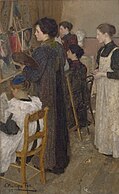 E. Phillips Fox, Art Students, 1895
E. Phillips Fox, Art Students, 1895
-
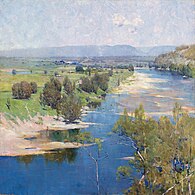 Arthur Streeton, The purple noon's transparent might, 1896
Arthur Streeton, The purple noon's transparent might, 1896
Federation era and World War I (1901–1918)
In 1901, the six self-governing Australian colonies federated to form a unified nation. Artists such as Hans Heysen and Elioth Gruner built on the Australian landscape tradition of the Heidelberg painters, creating grand, nationalist pastoral landscapes. Others moved on to successful careers in London and Paris, such as Rupert Bunny and Hugh Ramsay.
-
 George Washington Lambert, Miss Thea Proctor, 1903
George Washington Lambert, Miss Thea Proctor, 1903
-
 Hugh Ramsay, The Sisters, 1904
Hugh Ramsay, The Sisters, 1904
-
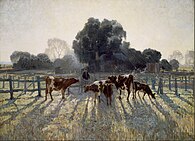 Elioth Gruner, Spring Frost, 1918
Elioth Gruner, Spring Frost, 1918
-
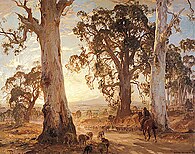 Hans Heysen, Droving into the Light, 1921
Hans Heysen, Droving into the Light, 1921
1920s onwards
Among the public, through the 1920s, modified forms of Impressionism were popular, with Elioth Gruner being considered the last of the Australian Impressionists. The Australian Tonalist movement, originating in the writings and teaching of Max Meldrum, followed a 'scientific' transcription of tonal relations, making 'impressionism' a system, and opposed Modernist art then emerging pre-WW2 in the Angry Penguins and the Heide Circle influenced by refugees from Europe, and Australian-born artists' visits to England and France. Conservatives' attitudes to 'modern art' prevailed until the 1960s, institutionalised in the Australian Academy of Art (1937–1947), opposed by such groups as the Contemporary Art Society (established 1938 and continuing).
The 1950s restored an interest in the Outback as subject matter in Australian art. Russell Drysdale and Sidney Nolan toured the interior, sponsored by newspapers to document drought. They and Albert Tucker, in his Explorer series, sought to capture the ancient strangeness and a cruel infinity of the central Australian landscape.
Splatt and Burton (1977) consider the 1960s a period in which public attention was being drawn to urban bushland and that landscape paintings of the 1970s carried through on the themes of environmental preservation and threats of destruction.
List of artists
Main pages: List of Australian artists, Category:Australian sculptors, and Category:Australian photographersArt museums and galleries in Australia


Institutions
Australia has major art museums and galleries subsidised by the national and state governments, as well as private art museums and small university and municipal galleries. The National Gallery of Australia, the Gallery of Modern Art and the Art Gallery of New South Wales have major strengths in collecting the art of the Asia Pacific Region. Others include the National Gallery of Victoria in Melbourne, which has a significant Australian collection of Western art. Museum of Contemporary Art Australia, Sydney, and the privately owned Museum of Old and New Art in Hobart, Tasmania and White Rabbit Gallery in Sydney are widely regarded as autonomously discerning collections of international contemporary art.
Other institutions include the Art Gallery of South Australia in Adelaide, Newcastle Art Gallery, the National Portrait Gallery of Australia, the National Museum of Australia, the Canberra Museum and Gallery, the Tasmanian Museum and Art Gallery in Hobart, the Museum and Art Gallery of the Northern Territory in Darwin, and the Art Gallery of Western Australia in Perth. A network of regional public galleries have existed since the mid-1800s and one, Castlemaine Art Museum, is unique in specialising in Australian art. The State Library of New South Wales holds a significant collection comprising more than a quarter of a million artworks, many from the colonial period. More material is held by other national and state libraries.
Art market
The boom and bust cycle in contemporary art is evident in the 1980s colonial art boom ending at the time of the 1987 stock market crash and the exit of many artists and dealers, followed by the 2000s boom in Aboriginal dot painting and Australian late modernist painting, which ended at the time of the global financial crisis and growing collector and public interest in the international contemporary art circuit.
A 5% resale royalty scheme commenced in 2010 under which artists receive 5% of the sale price when eligible artworks are resold commercially for $1000 or more. Between 10 June 2010 and 15 May 2013, the scheme generated over $1.5 million in royalties for 610 artists. Some buyers object to paying any resale royalty while others do not mind a royalty going directly to the artists. However, they worry about further red tape and bureaucratic interference.
In 2014/15 there was a rediscovery of colonial art at auction. Affordable 20th-century rural scene painting is buoyant. While the inflated northern hemisphere art markets had anticipating a massive correction in the Australian art market which transitioned to the middle market.
Socially oriented art events such as art fairs and biennials have continued to grow in size and popularity in the contemporary art scene.
The smaller commercial galleries have struggled to remain in business in the 2010s in spite of a functioning economy, although there is little consensus on the reasons for this.
A new market has arisen in China, where Australian artists are selling works in a traditionally local market: "While the Chinese have always had a passion for traditional Chinese art, according to global auction house Sotheby's, the surging interest in contemporary international art is a recent trend."
The market for Aboriginal art is still very strong, on the national and international stage, since becoming a solid financial investment in the 1980s. Not only do all the regional and State Galleries acquire significant collections of Aboriginal art, but private galleries are showing featured artists abroad. Aboriginal artists are also represented in all the major landscape prizes Australia. In 2019, "the Wynne prize, worth $50,000, was won by Sylvia Ken for her painting Seven Sisters – marking the fourth year in a row that the landscape prize has been won by Indigenous artists."
Australian visual arts in other countries
The museum for Australian Aboriginal art 'La grange' in Neuchâtel, Switzerland, was one of the few museums in Europe that dedicated itself entirely to Aboriginal art.
See also
- Arts in Australia
- Australian artist groups and collectives
- Australiana
- Australian Cartoonists' Association
- Australian feminist art timeline
- Photography in Australia
References
- "Indigenous art". Australian Culture and Recreation Portal. Australia Government. Archived from the original on 16 April 2010. Retrieved 26 September 2010.
- "Kakadu National Park". parksaustralia.gov.au. Retrieved 27 August 2020.
- Uluru-Kata Tjuta National Park Archived 27 December 2009 at the Wayback Machine
- Ku Ring Gai Chase National Park, Sydney, Australia. Information and Map Archived 29 January 2013 at the Wayback Machine
- * ABC Online 10.02.09 Pilbara Rock Art not Affected by Mining Emissions: Study
- Phillips, Yasmine: World protection urged for Burrup art. 13.01.09
- The spread of people to Australia, Australian Museum
- "The Indigenous Collection". The Ian Potter Centre: NGV Australia. National Gallery of Victoria. Archived from the original on 7 October 2010. Retrieved 6 December 2010.
- Arnhem Land Rock Art on Archaeology TV
- Australian Indigenous art, australia.gov.au Archived 16 April 2010 at the Wayback Machine
- "Hermannsburg School".
- "Aboriginal & Torres Strait Islander art". nga.gov.au. Retrieved 27 August 2020.
- "Protect Australia's Spirit – Griffith University". Archived from the original on 17 January 2012. Retrieved 16 December 2011.
- Protect Australia's Spirit: Interview with Prof. Paul Tacon and Jack Thompson on YouTube
- ^ Art in Australia: From Colonization to Postmodernism. Christopher Allen (1997). Thames and Hudson, World of Art series.
- ^ James Gleeson, Australian Painting. Edited by John Henshaw. 1971.
- "The Scott sisters collection".
- ^ Australian Painting: 1788–2000. Bernard Smith with Terry Smith and Christopher Heathcote (2001). Oxford University Press.
- "National Gallery of Australia. Travelling exhibitions" (PDF). National Gallery of Australia. Retrieved 27 August 2020.
- ^ McCulloch, Alan McCulloch, Susan McCulloch & Emily McCulloch Childs: McCulloch's Encyclopedia of Australian Art Melbourne University Press, 2006
- 'Evening shadows, backwater of the Murray, South Australia', Art Gallery of South Australia. Retrieved 27 February 2017.
- ^ Alan McCulloch, Golden Age of Australian Painting: Impressionism and the Heidelberg School
- ^ Splatt, William; Burton, Barbara (1977). A Treasury of Australian Landscape Painting. Rigby. p. 36. ISBN 9780859020138.
- "Pictures Collections – Getting started", State Library of New South Wales
- Arts, Department of Communications and the (17 December 2019). "Resale Royalty Scheme". arts.gov.au. Retrieved 27 August 2020.
- "Artforum.com". artforum.com. Retrieved 27 August 2020.
- "Top 38 International Art Fairs To Attend". Le Paulmier Photography. 22 August 2019. Retrieved 27 August 2020.
- Preiss, Andrea Petrie and Benjamin (11 May 2013). "Bleak picture emerges as galleries battle to hang in". The Sydney Morning Herald. Retrieved 27 August 2020.
- Fairley, Gina (16 August 2017). "Why are so many commercial galleries closing?". ArtsHub Australia. Retrieved 27 August 2020.
- "Aussie artists eye cashed-up Chinese buyers spending big on contemporary art". Australia: ABC News. 28 September 2018. Retrieved 27 August 2020.
- "History and Emergence of Aboriginal Art". Japingka Aboriginal Art Gallery. Retrieved 27 August 2020.
- "Desert Blossoms of Bush Medicine 'Akwerlp Alpeyt Artna Arntetyew' – Art Exhibition". Michael Reid Gallery. Retrieved 27 August 2020.
- "Indigenous artist wins landscape art prize". SBS News. Retrieved 27 August 2020.
- "Tony Costa named winner of 2019 Archibald prize for portrait of Lindy Lee". The Guardian. 10 May 2019. Retrieved 27 August 2020.
- "Fondation Burkhardt-Felder | Arts et Culture" (in French). Retrieved 27 August 2020.
- "Current Exhibition | Fondation-bf". Retrieved 13 February 2020.
External links
- National Association for the Visual Arts
- Australian Commercial Galleries Association
- Craft Australia's website
- Australian Video Art Archive
- Design and Art Australia Online
- Art Collector Magazine's Indigenous Art Centres Guide
- The Australian Arts Community – A free community website for the arts in Australia (archived)
- Art Prizes Australia, a free listing of Australian Art Prizes (archived)
| Oceanian art | |
|---|---|
| Sovereign states | |
| Associated states | |
| Dependencies and other territories | |
| Australia articles | |||||
|---|---|---|---|---|---|
| History |
| ||||
| Geography |
| ||||
| Politics |
| ||||
| Economy | |||||
| Society |
| ||||